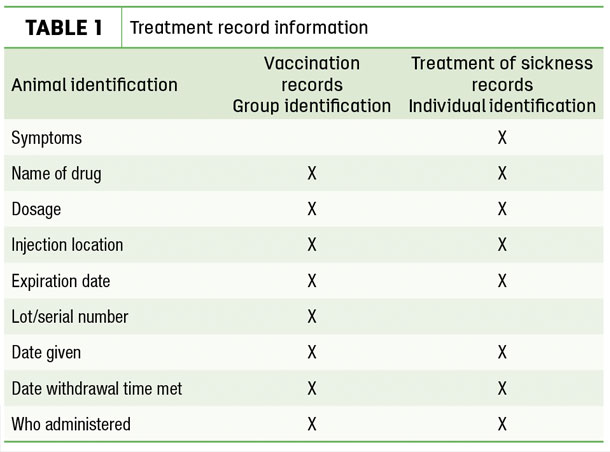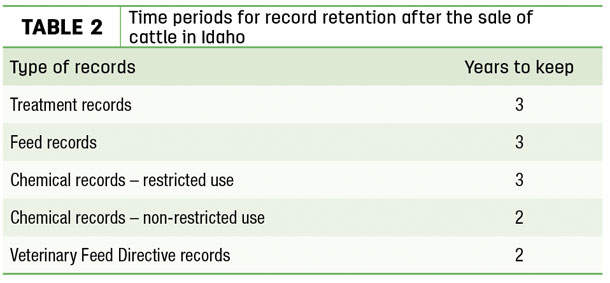The only defense in this scenario is through accurate production records.
A large component of Beef Quality Assurance programs and any beef operation is accurate records. Relying on memory for records is no longer suitable in today’s technological world where the public demands safe food products. Written records are a must to protect you and your operation.
Selection factors
The first step in a good recordkeeping system is to find a system that works for you and your operation. There are pros and cons for each system. For many operations, computer records are a must. There are a number of computer recordkeeping systems available online or retailed as software packages.
Oklahoma Cooperative Extension Service did a software survey a few years back. In their report, they have information from nine different software companies. The full report is online (Cow-calf production record software). As you look for a system, check the price.
Some systems require an annual fee, while others are a one-time purchase. Identify what equipment, features, benefits and customer service options come with the package.
Always have a backup system available for when equipment failures occur due to inclement weather, dead batteries, etc. Talk with other producers to see what programs they are using and how easy they are to use.
Research how many cattle you can enter into the program and the flexibility to record the information that is important for your operation. You may opt to utilize Excel spreadsheets so you can design the information exactly how you want it.
In your pocket
In addition to electronic options, there are several versions of the “pocket” record book for handwritten records. Many times, these record books are distributed by extension, farm and ranch stores, banks, etc. These record books allow you to record information about calving, pasture movement, calf performance, treatment records and provide an annual calendar.
If you utilize this method, ensure family and employees have a book and develop a plan to consolidate records. One of the advantages of the “pocket” book is that it is small and fits in a shirt pocket, so it is easy to carry all the time. These books are easily lost, so duplicating records or taking periodic copies will provide you with a backup system.
From the desktop
Wall, desk and personal calendars or planners provide additional recordkeeping options. One of the benefits of calendars is that you can easily record vaccination, medication and withdrawal dates. One disadvantage of this method is the limited space available to maintain all the necessary information.
You can easily record the date of treatment and the animals treated, but you may need another method to record the product used, lot number, injection site, dosage, etc.
As noted, many options are available for keeping records. Writing records on the chute or the side of the pickup with marking chalk is no longer sufficient. Determining a central location for the records and other pertinent information is crucial. Stay consistent with your recordkeeping plan and determine a weekly or monthly time to update and copy records.
Recording treatments
Once you decide how to keep records, the next step is to record required and necessary information. The “treatment” or working event determines what you need to record and how long you need to keep those records.
Table 1 outlines the information you should record. For basic vaccinations, you need a record of the description of the cattle group, the vaccine name, dosage amount, injection location, expiration date, date given, earliest withdrawal date and who administered.

A simple way to do this is to keep the box top off each box of vaccine and drop it into an envelope or folder. You can list the required details on the box top, the envelope or folder.
Any time you treat an animal for sickness, you need to record the animal’s individual identification number, the symptoms, diagnosis, date of treatment, product name, lot and serial number, dosage, injection site and who administered the drug.
It is very important you also record the withdrawal period. Make sure employees know that treated animals cannot be sold until the drug withdrawal period has concluded.
Some operations tag the tag of an animal with the date that drug withdrawal time has been met. You could also mark the animal with tail paint or marking chalk. This makes it easy to identify treated animals and eliminates the need to search for records.
If your veterinarian prescribes an “off-label” drug use, the withdrawal time may be increased. Follow the veterinarian’s prescription and make sure you understand the required withdrawal time.
What you feed
Feed records are also an important part of Beef Quality Assurance programs. When purchasing feed, particularly medicated feed, keep the receipts that list the amount purchased and the lot/batch number, who delivered and who received the product. In addition to medicated feeds, any time you treat a field with a pesticide, you need to make a record of those treatments.
You need to record the product name and EPA number, the date applied, where applied and how much applied. Keeping a copy of the label is also a good idea. Also record who applied the chemical and their license number. With all chemicals, read the label for any grazing or haying restrictions and follow those label instructions.
Record the dates when you can resume grazing on a field or hay the field. Private applicators must maintain these records for two years when using restricted-use pesticides.
The Veterinary Feed Directive (VFD) regulation has its own set of mandatory recordkeeping components. On the VFD drug, an expiration date will be listed. This defines the period of time you may utilize that VFD feed.
There will also be a “duration of use” noted. The duration of use determines the length of time an animal can consume the VFD feed. You need to keep a copy of the VFD, record the group of animals the feed is fed to, dates they received the feed, how much was given and the condition warranted for administration.
Storage and retention
Treatment records need to be saved and stored for a designated time period. Each state’s Beef Quality Assurance program may have different required time periods for record retention. For example, Table 2 shows how many years’ records need to be maintained after the sale of cattle in Idaho. Idaho BQA programs recommends you keep all records for three years.

If recordkeeping is not a top priority on your ranch, BQA programs encourage you to make it one. This practice will safeguard you, your employees and your operation.
If you ever do get that phone call about drug residues or questions regarding your production practices, you can verify you followed the required treatment practices and withdrawal times with accurate, accessible records. ![]()
PHOTO: When treating animals for sickness, you should record the ID number, treatment date, symptoms, diagnosis, among other details. Photo provided by Shannon Williams.

-
Shannon Williams
- Lemhi County Extension Educator
- University of Idaho
- Email Shannon Williams








